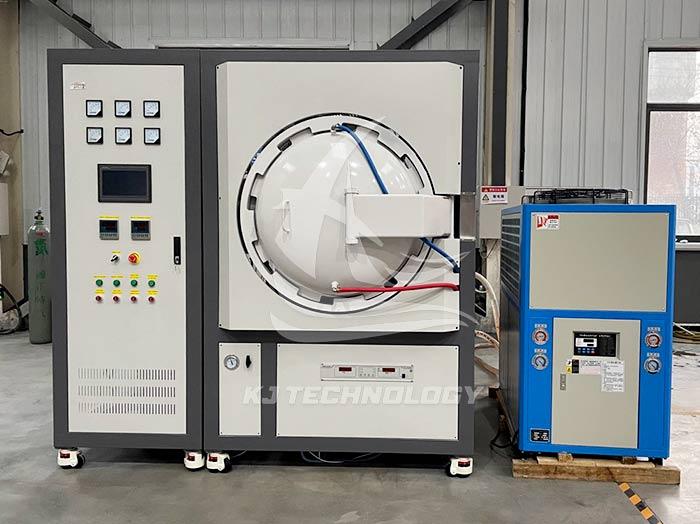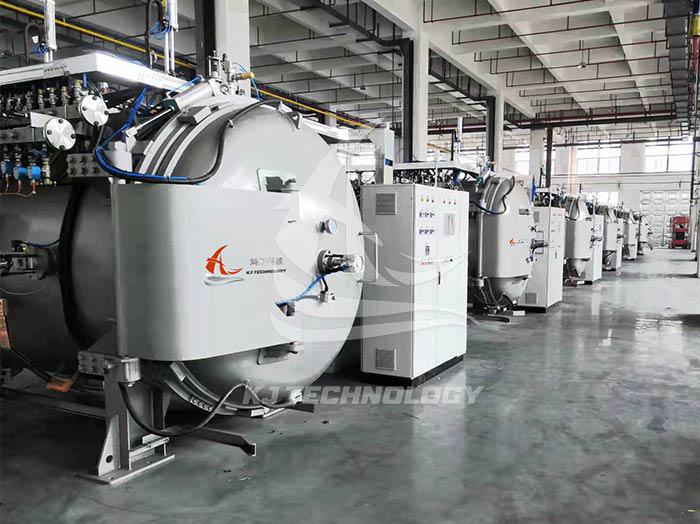Precautions for selection of high vacuum hot press furnace
 07-18-2025 Author: KJ technology
07-18-2025 Author: KJ technology
The selection of high vacuum hot press furnace needs to be comprehensively evaluated from five dimensions: process requirement matching, core performance parameters, equipment structure configuration, control system reliability, and manufacturer service capability. Specific precautions are as follows:
1. Process requirement matching: Clarify application scenarios and core indicators
temperature range
Select the upper limit of heating temperature based on material characteristics. For example, the sintering of silicon carbide ceramics requires ≥ 2150 ℃, while the processing of metal matrix composites may only require 1600-1800 ℃.
Key point: The nominal temperature of the equipment is the limit value, and a safety margin of 100-200 ℃ should be reserved for long-term use to avoid accelerated aging of heating elements.
Vacuum requirement
The decomposition pressure of metal oxides determines the minimum vacuum degree. For example, titanium alloy processing requires ≤ 10 ⁻ ³ Pa, while ordinary ceramic sintering may only require 10 ⁻ ² Pa.
Misconception: Blindly pursuing high vacuum degree (such as 10 ⁻⁶ Pa) can lead to a sharp increase in equipment costs and may cause the volatilization of alloy elements (such as aluminum and magnesium).
Pressure loading capacity
Hard materials (such as boron carbide ceramics) require a pressure of ≥ 50MPa, while soft materials (such as graphite) may only require 10-20MPa.
Case: Due to insufficient pressure, the density of boron carbide ceramics in a certain enterprise only reached 85%, far below the design requirement of 92%.
2. Core performance parameters: Ensure that the equipment meets the process limits
Temperature uniformity
Industry standards (such as AMS 2750D) define six levels of temperature uniformity:
First level furnace: ± 5 ° F (± 3 ° C), suitable for aerospace precision parts;
Four stage furnace: ± 20 ° F (± 11 ° C), meeting general industrial needs.
Optimization plan: Adopting three zone independent temperature control and graphite felt composite insulation layer can improve temperature uniformity to ± 8 ° C (secondary furnace standard).
Vacuum system configuration
Low vacuum (10 ⁻¹ -10 ³ Pa): single-stage rotary vane pump, suitable for ordinary sintering;
High vacuum (10 ⁻⁴ -10 ⁻⁶ Pa): a combination of molecular pump and diffusion pump to meet the needs of nanomaterial synthesis.
Cost comparison: The initial investment of the high vacuum system increases by 30% -50%, but it can be expanded to more high-end processes.
Heating element material
Graphite: resistant to high temperatures (≤ 2200 ℃), but easily reacts with oxygen and nitrogen, and needs to be used in a vacuum or inert atmosphere;
Carbon carbon composite material (CFC): Thickness reduced by 40%, heat storage capacity reduced by 60%, cooling rate increased by 2 times, but cost increased by 20% -30%.
3. Equipment structure configuration: ensuring long-term stable operation
Hot zone design
Circular hot zone: with a diameter of ≥ 500mm, it can accommodate higher parts and has better temperature uniformity than square hot zones;
Load bearing capacity: Choose the furnace structure based on the load weight. For example, processing 100kg of carbon fiber composite material requires the use of reinforced molybdenum supports.
Cooling method
Air cooling: air pressure ≥ 0.6MPa, flow rate ≥ 15m/s, cooling rate up to 50 ° C/min, suitable for most metal/ceramic composite materials;
Oil cooling: The cooling rate is faster (80 ° C/min), but it may cause surface carburization and is only suitable for specific steel grades.
Sealing structure
All metal seal: using indium wire or copper gasket, leakage rate ≤ 10 ⁻⁹ Pa · m ³/s, suitable for ultra-high vacuum environment;
Rubber O-ring: Low cost, but poor temperature resistance (≤ 200 ℃), only suitable for low vacuum scenarios.
4. Control system reliability: achieving precise process reproduction
temperature control
Adopting PID self-tuning algorithm and imported intelligent temperature controller, supporting multi-stage program heating (such as 10 stages) with temperature fluctuation of ≤± 1 ° C;
Case: A certain enterprise upgraded its control system and increased the ceramic sintering yield from 75% to 92%.
Vacuum degree interlock control
The vacuum degree is linked to the heating and inflation programs. For example, when the vacuum degree is ≤ 10 ⁻ ² Pa, heating will automatically start to avoid oxidation;
Data recording: Equipped with a 16 channel paperless recorder that can trace process curves and meet Nadcap certification requirements.
safety protection
Overpressure protection: Automatically release pressure when the pressure exceeds 10% of the set value;
Overtemperature alarm: When the temperature deviates from the set value by ± 5 ° C, an audible and visual alarm is triggered and the machine is stopped.
5. Manufacturer service capability: reduce long-term operational risks
Industry experience
Priority should be given to manufacturers who have served high-end fields such as aerospace and new energy. For example, the vacuum hot pressing furnace customized by Nanjing Weitu Vacuum Technology Co., Ltd. for a certain aviation enterprise has been running stably for 5 years without any faults.
after-sale service
Response time: The manufacturer is required to provide on-site service within 72 hours;
Spare parts inventory: Confirm the spot supply capacity of key spare parts (such as heating elements, vacuum pumps).
Certification qualifications
Check whether the equipment has passed CE, ISO 9001 and other certifications, and some industries (such as healthcare) also need to comply with FDA standards.








